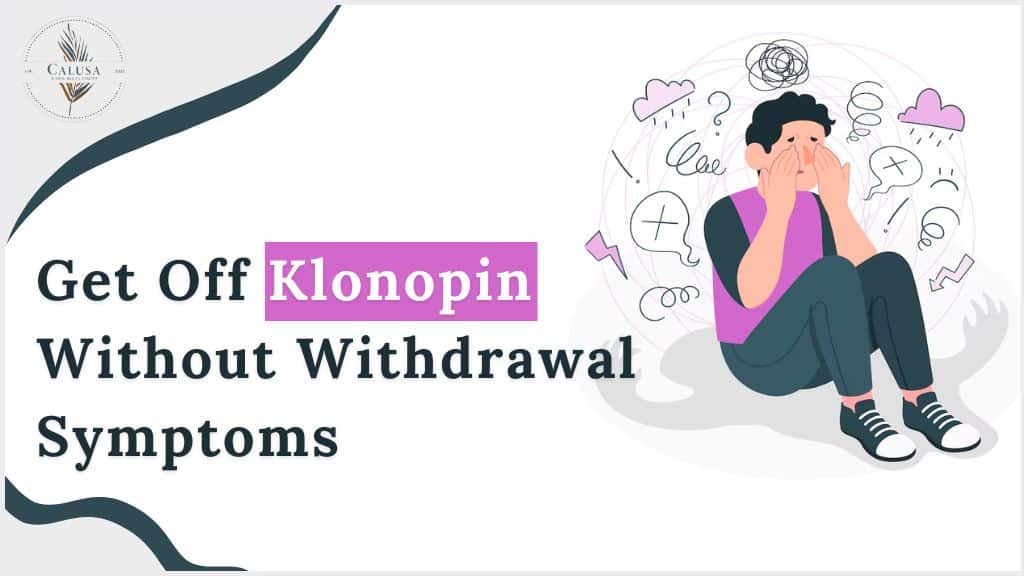In the domain of mental health, few challenges rival the journey of breaking free from benzodiazepines, particularly Klonopin. As a potent medication prescribed for anxiety disorders and certain seizure conditions, Klonopin can provide relief for those grappling with debilitating symptoms.
However, its prolonged use often leads to dependence and withdrawal symptoms, creating a formidable obstacle on the path to recovery. We aim to empower individuals with the knowledge and tools to safely and successfully navigate withdrawal-free recovery. Whether at the beginning of your journey or facing setbacks, freedom from Klonopin offers hope and guidance for reclaiming control over your health and future.
This concise yet comprehensive guide addresses the pressing question of “how to get off Klonopin without withdrawal.” Drawing from research, expert insights, and firsthand experiences, we provide practical strategies, holistic approaches, and compassionate support. Join us as we embark on this transformative path toward freedom and resilience.
What Does Klonopin Tapering Involve?
Gradually reducing your Klonopin dosage over time until discontinuation, known as Klonopin tapering, is a systematic approach. By slowly decreasing the medication intake, this method allows your body and mind to adapt to diminished drug levels, thus mitigating the potential for withdrawal symptoms. This method constitutes an essential aspect of how to get off Klonopin without withdrawal.
A closer look reveals the critical importance of tapering for the following reasons:
-
Reduces Dependence:
With prolonged use, Klonopin, similar to other benzodiazepines, has the potential to induce dependence, leading to a reliance on its effects for managing anxiety or other conditions. Tapering facilitates a gradual reduction in Klonopin dosage, allowing the body to adjust to lower levels of the medication and reducing the reliance on its pharmacological effects. This process supports a smoother transition towards independence from Klonopin and minimizes the risk of withdrawal symptoms.
-
Manages Withdrawal:
Abruptly discontinuing Klonopin can prompt the onset of withdrawal symptoms, which may include heightened anxiety, persistent insomnia, and in severe cases, even seizures. Tapering, however, facilitates a gradual reduction in dosage, allowing the body to acclimate to diminishing levels of the medication. This method fosters a smoother transition, significantly mitigating the likelihood and intensity of withdrawal symptoms, thereby promoting a more comfortable and manageable withdrawal process.
-
Improves Success Rates:
Research indicates that a tapering strategy substantially enhances the likelihood of successfully discontinuing Klonopin compared to abrupt cessation. Tapering is associated with higher rates of sustained withdrawal-free recovery, underlining its effectiveness as a gradual and systematic approach to medication cessation.
In essence, tapering is a strategic retreat from Klonopin dependence, allowing for a safer and more comfortable journey toward recovery.
Comprehending Klonopin Withdrawal
Navigating through Klonopin withdrawal poses a notable obstacle in achieving liberation from the medication. Anticipating potential withdrawal challenges is vital. Here’s an exploration of Klonopin withdrawal to empower you with insights on how to get off Klonopin without withdrawal:
-
Symptoms:
Withdrawal symptoms can be physical and psychological. Common physical symptoms include insomnia, headaches, tremors, nausea, and muscle tension. Psychological symptoms may involve anxiety, irritability, mood swings, and difficulty concentrating.
-
Timeline:
The onset of withdrawal typically occurs within 24-72 hours after the last dose. Symptoms often peak within the first week and gradually subside over several weeks or months, depending on the individual and tapering schedule.
-
Severity:
Withdrawal severity varies greatly. Some people experience mild discomfort, while others face more intense symptoms. Factors like dosage, duration of use, and individual metabolism all play a role.
Remember that by gradually reducing your Klonopin dose under medical supervision, you significantly decrease the likelihood and severity of withdrawal symptoms.
Creating a Tapering Strategy
Embarking on the journey to discontinue Klonopin requires careful planning and strategy. One of the fundamental steps in this process is developing a tapering plan. Let’s explore the essential components of creating a tapering strategy to facilitate a smoother transition toward freedom while ensuring how to get off Klonopin without withdrawal:
-
Consulting Your Doctor:
Self-tapering Klonopin is highly discouraged. A medical professional can assess your individual needs, create a personalized tapering schedule, and monitor you for potential withdrawal symptoms.
-
Tailored Approach:
There’s no one-size-fits-all tapering plan. Factors like your current dosage, duration of use, and overall health will influence your specific schedule. Your doctor will consider these aspects to create a safe and manageable reduction plan.
-
Tapering Pace:
Generally, slower tapers are better. Smaller, gradual dose reductions spread over more extended periods allow for smoother adjustments and minimize withdrawal risks. Your doctor will determine the optimal pace for your situation.
-
Dosage Considerations:
Klonopin comes in various tablet strengths. Depending on your current dose and the planned taper rate, your doctor might prescribe liquid solutions or split tablets to facilitate precise reductions.
Discuss your goals, concerns, and any withdrawal symptoms you experience openly with your physician to guide and support you throughout the tapering process.
Significance of Gradually Discontinuing Klonopin
Slowly reducing Klonopin isn’t merely a suggestion; it’s pivotal for a safe and prosperous path toward discontinuation. Understanding the necessity of a gradual tapering process is fundamental in ensuring a journey free from withdrawal symptoms. Here’s why this gradual reduction is essential for how to get off Klonopin without withdrawal:
-
Manages Dependence:
When you take Klonopin regularly, your brain adjusts to its presence. Abruptly stopping disrupts this delicate balance, triggering withdrawal symptoms. Tapering allows your brain to slowly adapt to lower Klonopin levels, reducing dependence and minimizing the withdrawal response.
-
Minimizes Discomfort:
Withdrawal symptoms can be unpleasant and even debilitating. Tapering allows for a smoother transition, significantly reducing the intensity and duration of these symptoms.
-
Boosts Success Rates:
Studies have shown that tapering Klonopin significantly increases the chances of successful discontinuation compared to quitting cold turkey. Think of it as setting yourself up for long-term success by avoiding the challenges of abrupt cessation.
-
Empowers Recovery:
Tapering is an active process that puts you in control by providing a gradual adjustment to lower medication levels, minimizing withdrawal symptoms and discomfort.
In essence, tapering is a strategic retreat from Klonopin addiction. It allows your body and brain to adjust at a manageable pace, minimizing pullback symptoms and maximizing your chances of a successful and comfortable recovery.
Assistance Systems for Managing Withdrawal.
While tapering is a vital element, a successful journey off Klonopin often involves a broader support system. Here’s how to leverage additional tools and resources to manage withdrawal symptoms and enhance your recovery journey, by ensuring how to get off Klonopin without withdrawal:
-
Medical Support:
Your doctor remains your primary source of guidance. They can adjust your taper plan as needed, prescribe medications to manage specific withdrawal symptoms, and monitor your overall well-being.
-
Therapy:
Talking to a therapist can be immensely helpful. They can provide tools for coping with anxiety, managing stress, and developing healthy coping mechanisms to replace reliance on Klonopin. Support groups can also be useful for connecting with others who comprehend your battles.
-
Holistic Practices:
Explore complementary therapies like mindfulness meditation, yoga, or acupuncture to manage stress and promote relaxation. These practices can help you develop tools to regulate your nervous system and improve your overall well-being during withdrawal.
-
Healthy Habits:
Prioritize a healthy lifestyle. Eat nutritious foods, get regular exercise, and ensure adequate sleep. A strong foundation of self-care empowers your body and mind to cope with the challenges of withdrawal.
-
Supportive Relationships:
Encircle yourself with loved ones who apprehend your journey and deliver encouragement. Open communication with supportive friends and family can create a safe space for you to express your challenges and celebrate your successes.
By building a comprehensive support system that incorporates the approaches mentioned above, you can effectively manage withdrawal symptoms and navigate the path to healing with greater confidence and empowerment.
FAQ
Can Klonopin be Safely Tapered Off Without Medical Supervision?
Discontinuation of benzodiazepines such as Klonopin carries risks, including the potential for seizures, underscoring the importance of medical detox as an essential element in ensuring a safe withdrawal journey.
Can Natural Remedies Help with Klonopin Withdrawal?
Natural remedies like mindfulness, herbal supplements, and relaxation techniques can assist in managing Klonopin withdrawal symptoms but should be used alongside medical guidance. Consulting with a healthcare professional ensures their safety and compatibility with individual needs.
Is Klonopin Withdrawal Dangerous?
If not handled with caution, Klonopin withdrawal can present various risks, including the possibility of seizures. Seeking medical guidance is essential to ensure a safe withdrawal process.
Conclusion
In conclusion, reclaiming freedom from Klonopin dependency is a journey that demands diligence, patience, and a multifaceted approach. Recognize, that the path to freedom may present challenges, but with determination and support, how to get off Klonopin without withdrawal is an achievable goal, leading to a brighter and healthier future.
With dedication and the guidance outlined in this guide, you can reclaim your freedom and embrace a life of empowered well-being. We encourage you to take the first step by reaching out to us by visiting our website https://calusarecovery.com/ or by calling us at 866-939-6292, to discuss your desire to taper off Klonopin.

